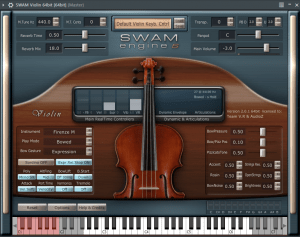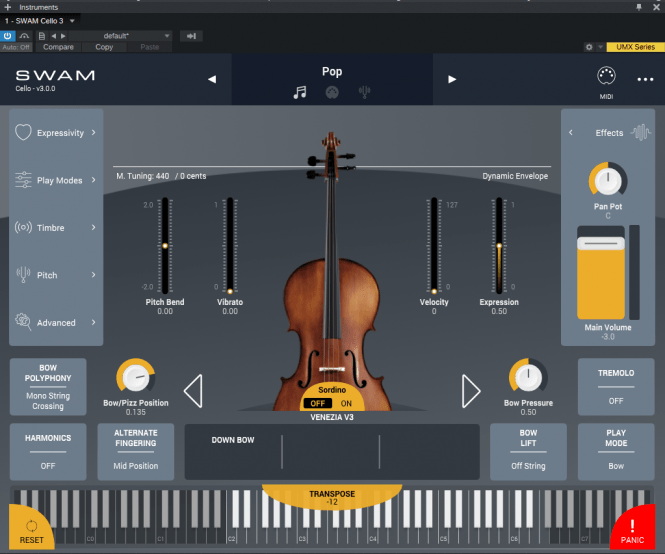


I was immediately bowled over by the flute's sheer playability and lovely full, lyrical tone, prompting an extended improvisation which threatened to go on for hours. Between these two extremes are the 'jazz' and 'funk' styles, the first of which has enough attack definition for most purposes and thus serves as an ideal default setting.

Thus, the Flute's 'Style' slider allows you to run the gamut from 'classical' (featuring a pure-sounding, restrained attack) to 'ethnic', whose spitty, octave–overtone note fronts are reminiscent of a Japanese shakuhachi. Rather than giving users dozens of patches to wade through, the makers opted for a single all-in-one instrument containing all possible stylistic and timbral options.

The main page of the SWAM Flute interface. The latter's sumptuous low register enables you to write four-part flute arrangements spanning over five octaves from A2 to C8, an attractive colour rarely heard in today's media music. SWAM Flute comprises piccolo, flute, alto flute and bass flute. FluteĪudio Modeling's solo woodwinds conveniently group together different members of the same instrument family in one package. We'll take a look at Audio Modeling's current range, which divides neatly between those two solo instrument groups.
Swam violin vst torrent link software#
The player software (supplied free when you buy an instrument) comes in two flavours: SWAM-W for woodwinds, and SWAM-S for bowed strings. If you plan to use it on stage, it's worth noting that Audio Modeling have developed their own Camelot host with live performance in mind. It has no stand-alone version, so if you want to run it outside of your DAW you'll need a separate VST or AU host.
Swam violin vst torrent link Pc#
The SWAM sound engine runs as a VST, AU or AAX instrument plug-in on PC and Mac systems (see the 'System Requirements' box below). Because such mobile articulations are hard to pin down with fixed samples, SWAM introduces physical modelling (note correct spelling) to accurately mimic instruments' real-life behaviour. Without getting too technical, it's optimised for acoustic instruments which require continuous control of performance techniques - a violinist gliding from pitch to pitch, a variable-speed clarinet trill, or a flautist gradually introducing vibrato while swelling the volume of a note. It now falls to your intrepid reviewer to investigate further.įor those who enjoy bewildering acronyms, SWAM stands for Synchronous Waves Acoustic Modelling, a proprietary technology conceived by Stefano Lucato and developed by Emanuele Parravicini. A minor legal kerfuffle ensued (details in the box below) and an amicable resolution finally reached: Audio Modeling began selling their own products, adding new instruments to the SWAM range which caught the ear of SOS's editorial team at a recent NAMM show. I'm pleased to say the company are still going strong, though there was a bit of a hiccup in 2017 when a split in the ranks led to the formation of a breakaway outfit, cunningly titled Audio Modeling. Audio Modeling's SWAM range delivers a complete suite of virtual solo woodwinds and strings.īack in the day (October 2012, to be precise) I waxed lyrical about Sample Modeling's solo wind instruments.


 0 kommentar(er)
0 kommentar(er)
